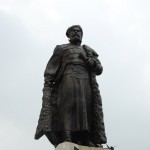Khabarovsk
History as it is according to historians and students of local lore.
One of the first Russian explorers who came to the banks of the Amur River was Yerofey Pavlovich Khabarov. More than 350 years ago now he and his detachment of 70 people followed Vasily Poyarkov and set off to explore unknown lands. Having come up on the Lena River, Khabarov and his men reached the Olekma River and then along the Tugir River reached Urka – a tributary of the Amur. Here and below along the Amur they met the first settlements of dauri people. Y. P. Khabarov left a part of his detachment there and returned to Yakutsk to prepare a second, larger expedition. The first expedition of Y. P. Khabarov resulted in “The Drawing of the Amur River” he made and a detailed report he sent to Moscow in which he wrote: “…Dauri land is more profitable than Lena… and more than the rest of Siberia this place will be beautiful and abundant…” This is what predetermined Russian rulers’ big interest in the Far East.
After this outstanding explorer a military post of Khabarovsk was named in the future founded on May 30 of 1858 by soldiers of 13th maneuver battalion under command of Y. V. Dyachenko. It was preceded by difficult Russian-Chinese negotiations in the Chinese city of Ay-Gung (30 miles down the Amur River from the city of Blagoveschensk). The Russian side was represented by governor general of Eastern Siberia N. N. Muravyov. The negotiations resulted in signing a treaty stating that the whole eastern bank of the Amur passed into possession of Russia while the right bank down to the Ussur belonged to China, and territory from the Ussur to the shore was in dual possession of China and Russia. For successful negotiations with China N. N. Muravyov received the title of a count, and an attachment “of Amur” was added to his name.
Khabarovka was located in a very convenient place: where two mighty far-eastern rivers – Amur and Ussuri – mingled together. Because of the very convenient location Khabarovka began to develop very fast. Soldiers and official men were followed closely by enterprising people. Main occupations at that time were fur and fish trades and unequal exchange with native inhabitants. Those were very profitable businesses and attracted a lot of people. They were also attracted by a lot of fertile land which was given out for free. In six years a military topographer Mikhail Lyubensky designed a plan of building up of Khabarovka. According to this plan Riverside Street (which today is Shevchenko St.) became the main street.
Fast development of Khabarovka required improvement of means of transportation and communication with other big centers in the Far East. For instance, only 10 years after the settlement was founded a telegraph line Khabarovka–Vladivostok was opened. After 4 more years a river port was built. The population increased almost 3 times as many, educational institutions became required: in 1873 the first primary school in Khabarovsk was opened.
By 1880 Khabarovka already became a pretty big settlement. By that time there emerged a necessity to move the capital of the region from Nikolayevsk-upon-Amur to another place. Khabarovka had a more preferable geographical location since it was built at all the crossroads of all the routes of communications from Vladivostok and the coast. That is why it was decided to give Khabarovka status of a city and in 1884 to move here the capitol of the recently formed Amur River Governorate General Region. At that time Khabarovka receives its first official emblem which also became the official emblem of the Governorate General. This is how it looked like: “In a silver shield there’s an azure pillar between two black sugar loaf mountains with dark red flames. The shield is crowned with an ancient Tsar’s crown and is surrounded with golden oak leaves joined together by an Alexander’s Ribbon.” The black mountains signified the volcanoes of Kamchatka. The emblem of Khabarovka belongs to the category of honorary heraldry as evidenced by the vertical pillar in the middle.

